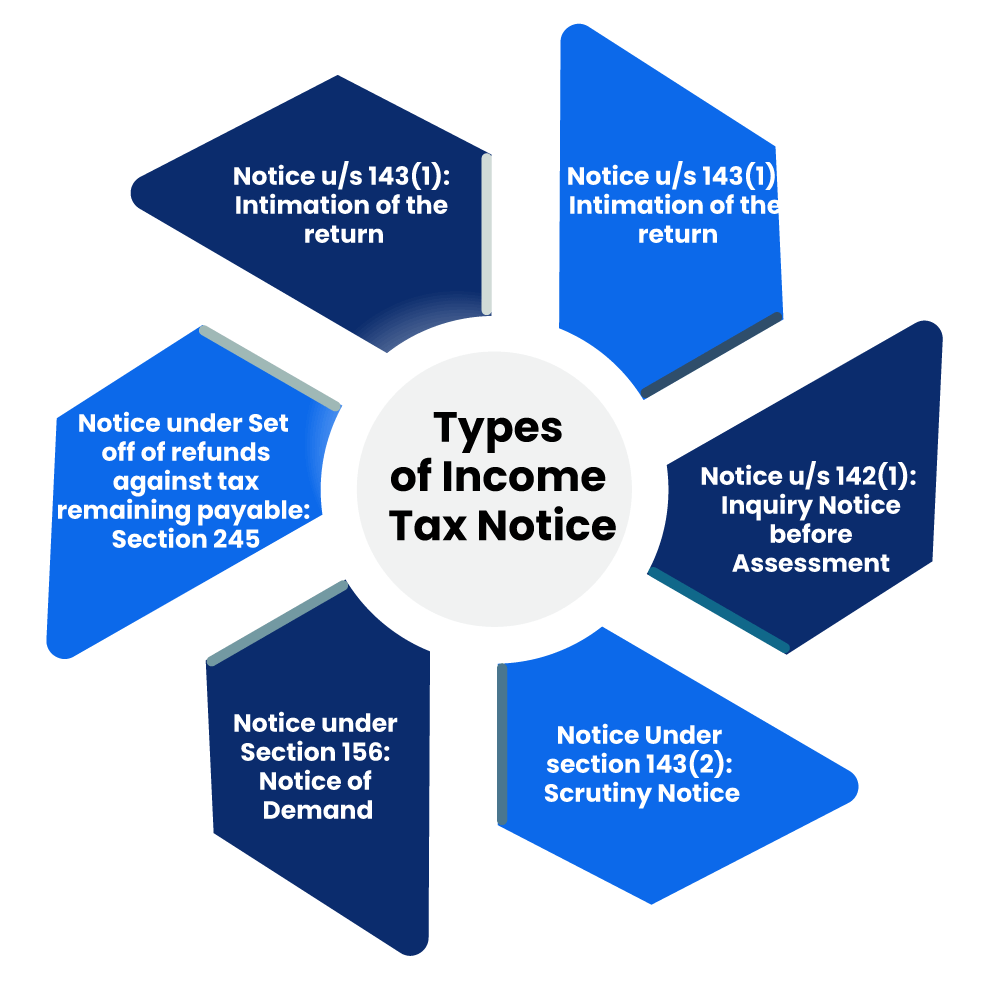Income Tax Notice
When a tax payer files the income tax return to the department, then after the submission of the return, then the department process the return and at that time department may issues various type of notice to the tax payer, which may be sometimes in the form of Intimation or may be some time in the form of scrutiny.
Tax-Payer may always get worried of Income tax notice when they heard of it, but there is nothing to be worry about it. There is always a reason for the notices.
We need to understand the notice issued by Income tax department.
Types of Income Tax Notice
The following are the types of income tax notice:

1. Notice u/s 143(1): Intimation of the return
When we file the Income tax return, the same is electronically processed by the Income tax department, After processing the department sends the intimation to the assesses in three instances:
- tax liability to be paid
- refund to be determined
- no refund or demand, but there is an increase or reduction in the amount of loss
Intimation from the department shall be received within one year from the end of the year in which the return has been filed.
2. Notice u/s 139 (9): Defective Income tax return
At the time of processing the return, if the department finds any defect, mistake or missing information in the return filed, then the department issue the notice u/s 139 (9) to ratify the error. Department cross verify the return from the information they already have.
Defective return shall be file within 15 days, if the response is not filed within 15 days the return shall be treated as invalid.
3. Notice u/s 142(1) Inquiry Notice before Assessment
When a return is filed and during the assessment period, assessing officer is of the opinion to demand for the further details and documents. Then, the assessing officer may do so and it is obligatory on the part of assesse to furnish it.
4. Notice Under section 143(2): scrutiny Notice
After receiving the document in pursuant to the notice send u/s 142 (1), if the AO is still of the opinion that there is a need to do scrutiny, and then the AO may issue the notice u/s 143(2). The AO wants to satisfy, that the assesses has not done any of the following fault s:
- understated your income;
- claimed excessive loss; or
- paid lesser taxes
It is to noted that the section under which it will be scrutinized is different from the one in which the notice has been issued.
Scrutiny notice can be issued upto 6 months after completion of relevant assessment year.
No scrutiny assessment can be done of the assesses who has not furnished his return of Income. In such a case, Best Judgment is to be done by the AO and can assess the tax liability under it.
When a person has not filed the return of Income,
Section 143(2) enables the Assessing Officer to make inquiry and do the regular assessment.
If assesses do not comply with the provisions of this section:
1. It may result in Best Judgment Assessment u/s 144, or
2 Penalized under Sec 271(1) (b) i.e. Rs10, 000 for each failure, or
3 Prosecution under Sec 276D which may extend up to 1 year with or without fine.
Type of scrutiny notice which can be issue:
Limited Scrutiny“ These are the Cases in which the Income Tax Department has restricted the scope of the scrutiny to the particular area .Example: Claim of foreign tax credit, sale of property)
Complete Scrutiny “ In complete scrutiny, there is a complete scrutiny of all the relevant documents.
Manual Scrutiny “ In some cases, scrutiny are done in detail as per criteria set by CBDT.
Section-148 Notice under Income Escaping Assessment
Notice of Income escaping assessment by the income tax department is given, if AO is of the opinion that certain incomes has escaped assessed or income has been assessed at a lower rate as prescribed by the authorities or if excessive loss of allowances has been allowed. In such a situation, AO is entitled to reassess the assessment of the relevant assessment year.
It is the duty of the AO to rely on substantial evidence before initiating procedures
It is necessary that the assessing officer conducts his operations in good faith.
5. Notice under Section156- Notice of Demand
When any interest, tax, penalty, fine or any other sum is to be payable in respect to any order passed, then the AO shall serve upon the assesses a notice of demand, specifying the sum do payable.
6. Notice under Set off of refunds against tax remaining payable-section 245
When an amount is payable by the assesses and refund has to be claim by the assesses, then such transactions are inter-adjusted
It is kind of an intimation to the assesses not the notice issued.
How to reach TAP GLOBAL for Income Tax Notice

Fill The Form

Get a Callback

Submit Document

Track Progress

Get Deliverables